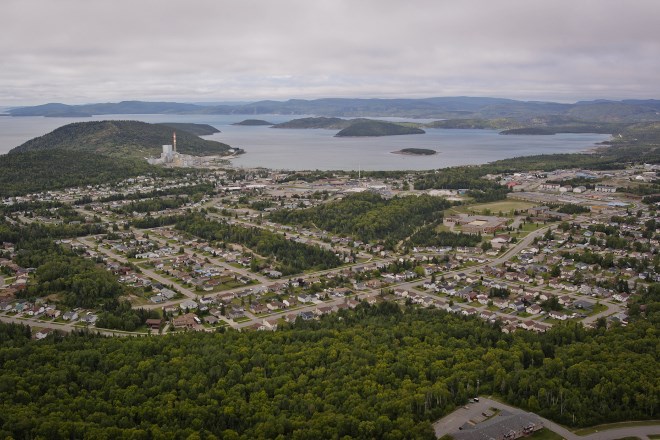The delivery of natural gas to five communities along the north shore of Lake Superior could arrive by late 2020.
Some outside-the-box thinking for a new affordable energy solution that began four years ago is now becoming a reality.
In late January, the Ontario government announced it was providing $27 million toward the construction of a liquefied natural gas (LNG) plant in Nipigon with designs on delivering a new fuel alternative to homeowners and businesses in communities struggling with onerous energy costs.
“Back in 2015, when a lot of people saw this project, they probably thought this will never fly,” said Daryl Skworchinski, CAO for the Town of Marathon.
“I think it’s a good example of what we can accomplish if we’re creative and have that stick-to-it mentality in Northern Ontario.”
Over the years, residents and small businesses in Marathon, Terrace Bay, Schreiber, Manitouwadge, and Wawa felt they were getting gouged by pricing spikes on fuel oil, propane, and grid power.
An earlier feasibility study estimated the introduction of LNG into these towns will save municipalities, business and homeowners more than $6 million annually.
The area’s rugged topography doesn’t allow for the expansion of natural gas pipelines into the communities, so they partnered with Northeast Midstream, a southern Ontario energy developer, to work on the economics of tapping into the cross-Canada natural gas pipeline at Nipigon.
LNG is natural gas cooled to minus 162 Celsius which is converted into liquid so it can be safely transported for use as fuel.
Northeast Midstream LP will build a liquefaction facility this fall, north of the Town of Nipigon, which will be connected by pipeline to the nearby TransCanada main line.
The liquid gas would be trucked to small depots in each community, heated to return the liquid back into gas and distributed by local pipelines into homes, institutional and commercial buildings.
Skworchinski said each community central depot will look very much like a propane depot with big tanks. But instead of home delivery trucks, there will be underground four-inch PVC pipes installed to individual customers, like water mains and laterals.
To determine the customer uptake in each community, Skworchinski said they’ll refresh an attachment study from 2016 that indicated between 70 and 80 per cent of the population in the communities would consider converting their home heating systems to natural gas. He feels those numbers are still solid.
“We’re in detailed discussions now to fund the capital construction in each community and the model we’re using is called tax increment financing.
“When the pipes are in the ground, (individual customers) have to pay property tax,” which would be returned to a local municipally owned local distribution company.
“It’s a pretty creative model. It doesn’t add to the municipality levy, no additional subsidization required and it utilizes the attachment model that’s in place to fund the project.”
The construction of the LNG plant is the only first phase of the project.
Queen’s Park has made an additional $3.4 million available through the Northern Ontario Heritage Fund for the five communities to do the front-end engineering, First Nations consultation, and environmental assessment as part of fulfilling all the regulator requirements in their application to the Ontario Energy Board (OEB).
How the distribution network will work, the frequency of deliveries to each community and the fuel supply at each community depot will be worked out as part of this process.
Stantec has been contracted to do this work on behalf of the five communities, which are contributing a combined $500,000.
Skworchinski said the plan is to have OEB approval by the end of 2019, put out the tender for construction in early 2020, with the first pipes being installed in the communities by late 2020 as part of a two to three-year build-out.
Two years ago, the LNG project looked dead when the previous Wynne government cut funding from a natural gas loan and grant program.
The project was resuscitated last fall with the Ford government’s passage of Bill 32, the Access to Natural Gas Act, geared toward expanding of natural gas distribution systems across rural and Northern Ontario.
“We were highly pleased that Bill 32 was passed,” said Skworchinski.
The LNG project could conceivably create thousands of construction and operational jobs at the Nipigon gas plant, and in trucking positions, the installation of local pipework networks, and various sales and service jobs at the local distribution companies to be established in each community.
“It would certainly be one of the bigger construction projects we’ve seen at a municipal level in recent times,” said Skworchinski.
On whether this operation is scalable, he said, at this point, adding more communities would change the scope and economics of the project. Once they get OEB approval, they can consider adding others, if the interest is there.
Industrial users are not part of this network, he said, as Northeast Midstream is already in separate discussions with area operating mines and forest products companies for direct business-to-business supply contracts.
There’s another natural gas company on the north shore, Certarus, which aims to serve industry customers, particularly mines, with compressed gas. But the company has no interest in serving the residential market.




